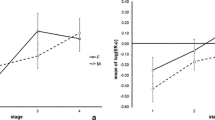Abstract
Throughout pregnancy in the rat, several hormones control luteal cell function (1). Following nidation, locally formed estradiol becomes essential for the activation of the steps necessary for optimal steroid production and for the growth and survival of the corpus luteum (1). Estradiol stimulation of luteal growth is accompanied by a remarkable proliferation of vascular endothelial cells. However, in contrast to its effect on other target cells, estradiol does not elicit luteal cell multiplication but rather cell hypertrophy and a marked increase in protein synthesis. Although the action of estradiol on overall protein synthesis is dramatic, its effect on such diverse parameters as steroidogenesis and vascularization strongly suggests that this steroid may stimulate specific proteins which mediate its broad spectrum of action.
Access this chapter
Tax calculation will be finalised at checkout
Purchases are for personal use only
Preview
Unable to display preview. Download preview PDF.
Similar content being viewed by others
References
Gibori G, Khan I, Warshaw ML, et al. Placental derived regulators and the complex control of luteal cell function. Recent Prog Horm Res 1988; 44:377–429.
Gibori G, Keyes PL. Role of intraluteal estrogen in the regulation of the rat corpus luteum during pregnancy. Endocrinology 1978; 102:1176–82.
Gibori G, Chen Y-DI, Khan I, Azhar S, Reaven GM. Regulation of luteal cell lipoprotein receptors, sterol contents, and steroidogenesis by estradiol in the pregnant rat. Endocrinology 1984; 114:607–17.
Khan I, Sridaran R, Johnson DC, Gibori G. Selective stimulation of luteal androgen biosynthesis by luteinizing hormone: comparison of hormonal regulation of P450170t in corpora lutea and follicles. Endocrinology 1987; 121:1312–9.
Heischner S, Kervina M. Subcellular fractionation of rat liver. Methods Enzymol 1974; 3:6–41.
Hubbard AL, Cohn ZA. Externally disposed plasma membrane proteins. J Cell Biol 1975; 64:438–60.
Laemmli UK. Cleavage of structural proteins during the assembly of the head of bacteriophage T4. Nature 1970; 227:680–5.
Chamberlain JP. Fluorographic detection of radioactivity in Polyacrylamide gels with the water-soluble fluor, sodium salicylate. Anal Biochem 1979; 95:132–5.
Bradford MN. A rapid and sensitive method for the quantitation of microgram quantities of protein utilizing the principle of protein-dye binding. Anal Biochem 1976; 72:248–54.
Chirgwin JM, Przbyla AC, MacDonald RJ, Rutter WJ. Isolation of biologically active ribonucleic acid from sources enriched in ribonuclease. Biochemistry 1979; 18:5294–9.
Vignon F, Capony F, Chambon M, Freiss G, Garcia M, Rochefort H. Autocrine growth stimulation of the MCF-7 breast cancer cells by estrogen-regulated 52 K protein. Endocrinology 1986; 118:1537–45.
Sheen YY, Katzenellenbogen BS. Antiestrogen stimulation of the production of a 37,000 molecular weight secreted protein and estrogen stimulation of the production of a 32,000 molecular weight secreted protein in MCF-7 human breast cancer cells. Endocrinology 1987; 120:1140–51.
Author information
Authors and Affiliations
Editor information
Editors and Affiliations
Rights and permissions
Copyright information
© 1989 Plenum Press, New York
About this chapter
Cite this chapter
McLean, M.P., Khan, I., Puryear, T.K., Gibori, G. (1989). Estradiol-Induced Synthesis and Translation of Specific Proteins in the Corpus Luteum. In: Hirshfield, A.N. (eds) Growth Factors and the Ovary. Springer, Boston, MA. https://doi.org/10.1007/978-1-4684-5688-2_46
Download citation
DOI: https://doi.org/10.1007/978-1-4684-5688-2_46
Publisher Name: Springer, Boston, MA
Print ISBN: 978-1-4684-5690-5
Online ISBN: 978-1-4684-5688-2
eBook Packages: Springer Book Archive




